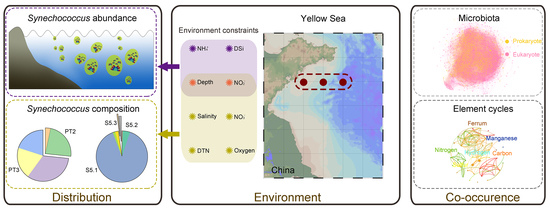Phylogenetic and Phenogenetic Diversity of Synechococcus along a Yellow Sea Section Reveal Its Environmental Dependent Distribution and Co-Occurrence Microbial Pattern
Abstract
Share and Cite
Wang, T.; Chen, X.; Qin, S.; Li, J. Phylogenetic and Phenogenetic Diversity of Synechococcus along a Yellow Sea Section Reveal Its Environmental Dependent Distribution and Co-Occurrence Microbial Pattern. J. Mar. Sci. Eng. 2021, 9, 1018. https://doi.org/10.3390/jmse9091018
Wang T, Chen X, Qin S, Li J. Phylogenetic and Phenogenetic Diversity of Synechococcus along a Yellow Sea Section Reveal Its Environmental Dependent Distribution and Co-Occurrence Microbial Pattern. Journal of Marine Science and Engineering. 2021; 9(9):1018. https://doi.org/10.3390/jmse9091018
Chicago/Turabian StyleWang, Ting, Xi Chen, Song Qin, and Jialin Li. 2021. "Phylogenetic and Phenogenetic Diversity of Synechococcus along a Yellow Sea Section Reveal Its Environmental Dependent Distribution and Co-Occurrence Microbial Pattern" Journal of Marine Science and Engineering 9, no. 9: 1018. https://doi.org/10.3390/jmse9091018
APA StyleWang, T., Chen, X., Qin, S., & Li, J. (2021). Phylogenetic and Phenogenetic Diversity of Synechococcus along a Yellow Sea Section Reveal Its Environmental Dependent Distribution and Co-Occurrence Microbial Pattern. Journal of Marine Science and Engineering, 9(9), 1018. https://doi.org/10.3390/jmse9091018







